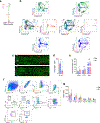Gut-educated IgA plasma cells defend the meningeal venous sinuses
- PMID: 33149302
- PMCID: PMC7748383
- DOI: 10.1038/s41586-020-2886-4
Gut-educated IgA plasma cells defend the meningeal venous sinuses
Abstract
The central nervous system has historically been viewed as an immune-privileged site, but recent data have shown that the meninges-the membranes that surround the brain and spinal cord-contain a diverse population of immune cells1. So far, studies have focused on macrophages and T cells, but have not included a detailed analysis of meningeal humoral immunity. Here we show that, during homeostasis, the mouse and human meninges contain IgA-secreting plasma cells. These cells are positioned adjacent to dural venous sinuses: regions of slow blood flow with fenestrations that can potentially permit blood-borne pathogens to access the brain2. Peri-sinus IgA plasma cells increased with age and following a breach of the intestinal barrier. Conversely, they were scarce in germ-free mice, but their presence was restored by gut re-colonization. B cell receptor sequencing confirmed that meningeal IgA+ cells originated in the intestine. Specific depletion of meningeal plasma cells or IgA deficiency resulted in reduced fungal entrapment in the peri-sinus region and increased spread into the brain following intravenous challenge, showing that meningeal IgA is essential for defending the central nervous system at this vulnerable venous barrier surface.
Conflict of interest statement
Figures











Comment in
-
B cells on the brain: meningeal IgA and a novel gut-brain firewall.Immunol Cell Biol. 2021 Jan;99(1):17-20. doi: 10.1111/imcb.12412. Epub 2020 Oct 27. Immunol Cell Biol. 2021. PMID: 33107992
References
Publication types
MeSH terms
Substances
Grants and funding
LinkOut - more resources
Full Text Sources
Other Literature Sources
Molecular Biology Databases
Miscellaneous

